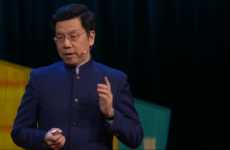
Need Inspiration?
Get inspired by 4,000+ keynote speaker videos & our founder, a top keynote speaker on innovation.
Floyd E. Romesberg's Talk on Semisynthetic Organisms is Engaging
Kalin Ned — November 28, 2018 — Keynote Trends
References: scripps.edu & ted
Floyd E. Romesberg — an experienced chemist and biologist, delivers a talk on semisynthetic organisms that is truly riveting, cutting-edge and carries great implications for the healthcare industry. In 1999, the speaker embarked on an adventure with his lab at the Scripps Research Institute in La Jolla, California. The objective was to develop a DNA with six genetic letters.
DNA is the most valuable component of the human system. It allows for cells to produce life-essential things like proteins, amino acids, etc. The DNA alphabet contains four letters — G, C, A and T, that split into pairs. In order to create the "first radically altered form of life," Romesberg and his lab tested hundreds of new candidate letters and their ability to selectively pair with each other. After 15 years of hard work, two new letters were found —Romesberg names them X and Y for ease of comprehension. Although still tested in tubes, this groundbreaking development unlocks immense possibilities in the sector of healthcare and pharmaceuticals.
In his talk on semisynthetic organisms, Floyd E. Romesberg dives into the conceptual and practical motivations behind the six-lettered DNA sample. For one, the new genetic makeup can serve as a base point to answer fundamental questions about human life. For example, "how perfectly created or evolved are we?" Secondly, and more importantly, a working semisynthetic organism can immensely assist in protein production. The innovation that Romesberg is most excited about has to do with protein drug application.
Since proteins are hard to make, having something make them for you will surely be of great benefit. Although still in the prototyping stages, Floyd E. Romesberg's lab and his biotech company — Synthorx, are hard at work at making the compound sustainable for the human organism. This entails things like making the protein safe and stable enough to be injected into a human and do its job.
During his talk on semisynthetic organisms, the scientist shows a picture that depicts them. They are green because they generate proteins that glow green. The protein is identified as a common component of jellyfish. Floyd E. Romesberg's lab is continuing its research in expanding the genetic alphabet to other cells — including human ones.
DNA is the most valuable component of the human system. It allows for cells to produce life-essential things like proteins, amino acids, etc. The DNA alphabet contains four letters — G, C, A and T, that split into pairs. In order to create the "first radically altered form of life," Romesberg and his lab tested hundreds of new candidate letters and their ability to selectively pair with each other. After 15 years of hard work, two new letters were found —Romesberg names them X and Y for ease of comprehension. Although still tested in tubes, this groundbreaking development unlocks immense possibilities in the sector of healthcare and pharmaceuticals.
In his talk on semisynthetic organisms, Floyd E. Romesberg dives into the conceptual and practical motivations behind the six-lettered DNA sample. For one, the new genetic makeup can serve as a base point to answer fundamental questions about human life. For example, "how perfectly created or evolved are we?" Secondly, and more importantly, a working semisynthetic organism can immensely assist in protein production. The innovation that Romesberg is most excited about has to do with protein drug application.
Since proteins are hard to make, having something make them for you will surely be of great benefit. Although still in the prototyping stages, Floyd E. Romesberg's lab and his biotech company — Synthorx, are hard at work at making the compound sustainable for the human organism. This entails things like making the protein safe and stable enough to be injected into a human and do its job.
During his talk on semisynthetic organisms, the scientist shows a picture that depicts them. They are green because they generate proteins that glow green. The protein is identified as a common component of jellyfish. Floyd E. Romesberg's lab is continuing its research in expanding the genetic alphabet to other cells — including human ones.
3.6
Score
Popularity
Activity
Freshness
















